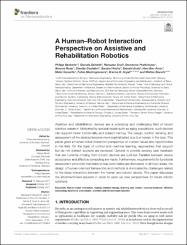| dc.contributor.author | Beckerle, Philipp | |
| dc.contributor.author | Salvietti, Gionata | |
| dc.contributor.author | Unal, Ramazan | |
| dc.contributor.author | Prattichizzo, Domenico | |
| dc.contributor.author | Rossi, Simone | |
| dc.contributor.author | Castellini, Claudio | |
| dc.contributor.author | Hirche, Sandra | |
| dc.contributor.author | Endo, Satoshi | |
| dc.contributor.author | Ben Amor, Heni | |
| dc.contributor.author | Ciocarlie, Matei | |
| dc.contributor.author | Mastrogiovanni, Fulvio | |
| dc.contributor.author | Argall, Brenna D. | |
| dc.contributor.author | Bianchi, Matteo | |
| dc.date.accessioned | 2019-07-05T09:45:24Z | |
| dc.date.available | 2019-07-05T09:45:24Z | |
| dc.date.issued | 2017 | en_US |
| dc.identifier.citation | FRONTIERS IN NEUROROBOTICS Volume: 11 Article Number: 24 DOI: 10.3389/fnbot.2017.00024 | en_US |
| dc.identifier.issn | 1662-5218 | |
| dc.identifier.other | PubMed ID: 28588473 | |
| dc.identifier.other | Accession Number: WOS:000401954300001 | |
| dc.identifier.other | DOI: 10.3389/fnbot.2017.00024 | |
| dc.identifier.uri | http://acikerisim.agu.edu.tr/xmlui/handle/20.500.12573/69 | |
| dc.description | The HUMORARR 2016 workshop did not receive direct support. This work was partially supported by the EU H2020 funded project SoftPro (no. 688857), the ERC advanced grant SoftHands (no. 291166), and the DFG projects Users' Body Experience and Human-Machine Interfaces in (Assistive) Robotics (no. BE5729/3) and "TACT-HAND: improving control of prosthetic hands using tactile sensors and realistic machine learning" (no. CA 1389/1). The support by the German Research Foundation and the Open Access Publishing Fund of Technische Universitt Darmstadt, Germany, is acknowledged. | en_US |
| dc.description.abstract | Assistive and rehabilitation devices are a promising and challenging field of recent robotics research. Motivated by societal needs such as aging populations, such devices can support motor functionality and subject training. The design, control, sensing, and assessment of the devices become more sophisticated due to a human in the loop. This paper gives a human-robot interaction perspective on current issues and opportunities in the field. On the topic of control and machine learning, approaches that support but do not distract subjects are reviewed. Options to provide sensory user feedback that are currently missing from robotic devices are outlined. Parallels between device acceptance and affective computing are made. Furthermore, requirements for functional assessment protocols that relate to real-world tasks are discussed. In all topic areas, the design of human-oriented frameworks and methods is dominated by challenges related to the close interaction between the human and robotic device. This paper discusses the aforementioned aspects in order to open up new perspectives for future robotic solutions. | en_US |
| dc.description.sponsorship | EU - 688857 ERC - 291166 DFG -BE5729/3 - CA 1389/1 German Research Foundation Open Access Publishing Fund of Technische Universitt Darmstadt, Germany | en_US |
| dc.language.iso | eng | en_US |
| dc.publisher | FRONTIERS MEDIA SA, AVENUE DU TRIBUNAL FEDERAL 34, LAUSANNE, CH-1015, SWITZERLAND | en_US |
| dc.relation.ispartofseries | FRONTIERS IN NEUROROBOTICS;Volume: 11 | |
| dc.rights | info:eu-repo/semantics/openAccess | en_US |
| dc.subject | human-robot interaction | en_US |
| dc.subject | human-oriented design | en_US |
| dc.subject | learning and control | en_US |
| dc.subject | sensory feedback | en_US |
| dc.subject | affective computing | en_US |
| dc.subject | functional assessment | en_US |
| dc.subject | assistive and rehabilitation robotics | en_US |
| dc.title | A Human-Robot Interaction Perspective on Assistive and Rehabilitation Robotics | en_US |
| dc.type | article | en_US |
| dc.contributor.department | AGÜ, Mühendislik Fakültesi, Makine Mühendisliği Bölümü | en_US |
| dc.contributor.institutionauthor | | |
| dc.relation.publicationcategory | Makale - Uluslararası Hakemli Dergi - Kurum Öğretim Elemanı | en_US |


















